Cool tranquility washes over anyone who enters the Temple of the People.
Cradled between Oceano and Arroyo Grande in the town of Halcyon—a Greek word meaning calm—the white building detailed with sky blue and lined with pillars cuts a triangular figure amid agricultural fields and scattered businesses.
On May 7, it provides respite from the sun that's already shining steadily at 10:30 a.m.
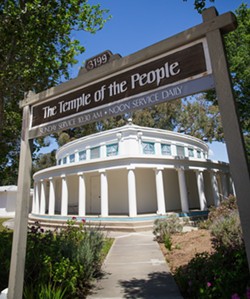
- Cover Photo By Jayson Mellom
- HIDDEN AWAY The Temple of the People is a quiet meeting place of the Theosophical Society cradled in Halcyon, near Oceano and Arroyo Grande, as an intentional community that follows the Golden Rule.
Inside, three rows of dark wooden chairs with deep blue seats face each other. A giant hand-built harp rests in one corner, a piano in another. The room's apex holds an altar with a second altar at the triangle's center, the heartbeat of the temple every Sunday morning.
Six elders in white and yellow robes tend to a table bearing two candlesticks, and a metal platter holds vials of liquid. One of them carries an incense burner similar to the swinging Catholic thurible. This is the Feast of Fulfillment, a communion service on the first Sunday of every month. The service was closed to the public until the early 1970s. Slowly, temple members trickle into the building, and the congregation swells to a modest 14.
Within the hour, one of the temple acolytes offers a platter of small glass communion cups to each attendee. The liquid within is colorless.
"The Catholics get wine, we get water," Halcyon resident Karen White whispers while she waits her turn.
It's blessed, holy water administered under the leadership of Guardian-in-Chief Rick London. The century-old tradition flourishes under the watchful eyes of spiritual masters and past temple leaders commemorated in black-and-white portraits along the walls of a space that nonmembers only recently gained access to.
The Temple of the People sprung up as an offshoot of the Theosophical Society in America when some of its followers moved from Syracuse, New York, to San Luis Obispo County in 1903. Most local members currently live in the homes scattered across Halcyon, upholding the town's original setup as an intentional theosophical settlement in the early 20th century.
Despite its long-standing existence, the Temple of the People is still shrouded in mystery. While the temple has 300 followers across the world—many of whom tune in through Zoom to attend the services—only 35 members live in SLO County, plus well-wishers like White who are active through its events.
Temple members aren't shy, though they refrain from proselytizing. Fear of the unknown, according to them, fills the gaps for local outsiders with misconceptions of the temple as being a hotbed for witchcraft and eerie practices.
But members are adamant about consciously following the Golden Rule: "Do unto others as you would have them do unto you."
They're willing to shed light on their community and have but one condition if others want to know more: Just ask with an open mind.
London's calling
London is the temple's sixth guardian-in-chief, following a series of leaders who alternated between women and men, with the first being Francia LaDue, who also went by the name of Blue Star.
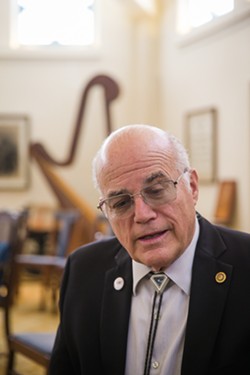
- Photo By Jayson Mellom
- A UNIQUE TIME Sixth Guardian-in-Chief Rick London currently leads the Temple at an extraordinary period in its history. For the first time, two guardians-in-chief are alive at the same time because his predecessor, Eleanor Shumway, voluntarily retired to take care of her health.
The excitement in London's voice was palpable this summer. He was poised to head the annual Temple Convention on Aug. 5 for the first time as guardian-in-chief, which also coincided with the 100-year anniversary of the then still roofless building being consecrated.
It was constructed with the help of notable Los Angeles architect Theodore Eisen after LaDue's death in 1922 with money she left behind and funds raised by Halcyon residents. It's called the Blue Star Memorial Temple in honor of LaDue.
"The temple was finally finished in October of 1924, and there was less than a dollar left over of the $6,000 that was raised," present Guardian-in-Chief London told New Times on July 13. "It would be a miracle now if we could paint it for $6,000!"
London assumed the lead role from fifth Guardian-in-Chief Eleanor Shumway, who retired due to ill health, last December after he stepped down as CEO of United Way of San Luis Obispo County.
London and his family moved to Nipomo from New York in 1993. His son's interest in the Halcyon Store introduced him to the community through a handful of temple pamphlets. In the summer of 1995—on the 23rd anniversary of his brother's death—London attended his first service at the temple. Participating in the short Noon Healing Service had a profound impact on him.
"Over the years I've held onto a practice of finding a special way of annually remembering my brother's life," he wrote in his July temple talk "Recalibrating Compassionately." "Seems like those first 20 minutes I spent in the Temple of the People had a significant impact on the recalibration of my life."
London became a regular, gleaning from other members and Shumway. He witnessed highs like bonding with his then preteen son through Temple Builders gatherings—a kids-focused group that's like Sunday school. Raised Jewish and married to a Catholic at the time, London said that watching his son give a temple talk when he turned 14 made him feel like he was witnessing his son's bar mitzvah or a confirmation.
"We celebrated Hannamas: Christmas and Hanukkah," London recalled. "My son would say he's a Cashew! He's become Catholic in his adulthood, and I'm grateful he has a spiritual connection to the world."
But London also witnessed lows. An enigma to most county residents outside of Halcyon, the temple and its members have raised suspicions.
Roughly 15 years ago, London was by Shumway's side when a rogue rock flew through one of the sacred geometric windows, shattering it. Someone had hurled it at the temple before running away.
"We made a police report, as we always reported vandalism," London said. "Within a week, Eleanor got a request from Arroyo Grande High School."
The school was helping a handful of students with troublesome streaks assimilate better socially. When asked to name 10 things that scared them, the nearby temple was a frequent answer.
"The school asked Eleanor if she could show them the temple. The students thought we were doing witchcraft in the basement," he said.
Shumway accommodated the request. After a tour of the temple basement strewn with decidedly less threatening paraphernalia like heaters, wheelchairs, and portable potties, she explained basic concepts of theosophy and temple teachings to the students.
"Every time I tell this story, I have a sense of wanting to cry," London said. "One of the boys got up and apologized for throwing the rock."
Practitioners of theosophy followed the spiritual thinking of Russian mystic Helena Blavatsky. She combined elements of Plato's philosophy with Christian, Hindu, and Buddhist thought, namely that the purpose of human life is spiritual emancipation, and that through karma, the human soul undergoes reincarnation upon bodily death. Unfettered by any strict codes of ethics, theosophy values universal brotherhood and social improvement.
In 1898, Theosophical Society members LaDue and William Dower continued Blavatsky's teachings by forming the Temple of the People as a spiritual practice. Dower, a doctor, established his medical practice in a three-story Victorian home they purchased in 1903 and named it the Halcyon Hotel and Sanatorium.
Confusion over the name is also common. London told New Times that some residents near Halcyon were convinced that the Temple of the People was the same as the Peoples Temple cult led by American preacher Jim Jones between the 1950s and the 1970s. The latter gained international notoriety for orchestrating a mass murder-suicide of 918 people in a remote jungle commune in Jonestown, Guyana.
"People were thinking we were affiliated with them," London said. "We are so vulnerable to be influenced. We are experts at taking things personally and making assumptions."
Like temple leaders before him, London has a second name as guardian-in-chief: Yellow Star. The color has deep roots with his family history. London's mother was a Holocaust survivor, and his father a second-generation Lithuanian Jew. Both sides of his family fled anti-Semitic persecution before finally making their way to the U.S.
"All of the Jews at the time had to wear a yellow Star of David. Yellow is a very sacred color in my mind, and it was made to look bad," he said. "Yellow is a very interesting color, too, because it's got a negative connotation to the point where cowards are yellow."
But yellow is dual-natured for London. It's positive too. He added that the ancient wisdom of theosophy holds colors in high esteem and sees all religion as an outgrowth of theosophical principles.
"I'm not trying to say theosophy is the only way to look at things, but we believe there are more similarities among them all than differences," London said of religions.
Essentially, London wishes for the world to be more spiritual, and yellow represents a tethering to the inner peace he found in theosophy.
"Jesus talked about all you need is enough faith the size of a mustard seed, and mustard is yellow," he said.
Homegrown care
Halcyon resident Damian Rollison knew the Temple of the People as his sole faith growing up. Flip through the Images of America book about Halcyon, and Rollison smiles out from one of its pages as a cheerful baby in 1970.
"My parents were married in the temple, and I was their first child," he said. "I moved away for a little while, but I did grow up here and came back as an adult."
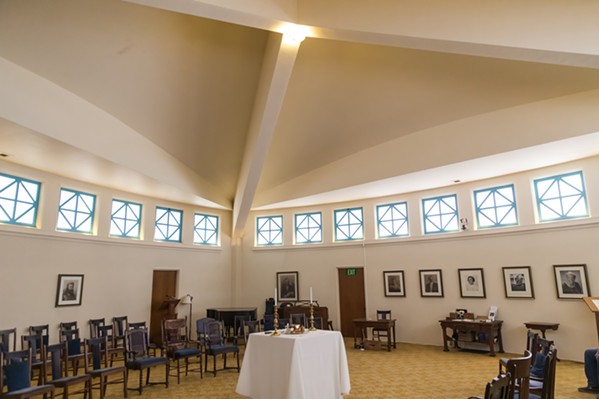
- Photo By Jayson Mellom
- SACRED GEOMETRY The temple's dimensions hold symbolic value for its members. The roof rises in a pyramidal form to a point in the exact center of the building, meeting above the central altar.
Fourth Guardian-in-Chief Harold Forgostein conducted his Naming Ceremony (similar to a christening); Rollison actively participated in the Temple Builders group as both a child and teenager; fifth Guardian-in-Chief Shumway married him and his wife at the temple; his own kids took part in Naming Ceremonies; and his mother conducted Temple Builder classes while his kids were around.
"The Halcyon community is very unusual in its ability to hold onto that old-time sense of small community where everyone supports each other, cares about each other," he said.
As a kid belonging to the Temple Builders group, Rollison recalled lessons that focused on humanity's inherent connection to nature and the importance of tapping into it.
Temple Builders' membership waxes and wanes depending on the number of children who attend services. Currently, the program is on pause. A small batch of toddlers do accompany their families to temple services—one of them being London's grandson—but they're not old enough to learn the lessons.
The camaraderie Rollison felt with fellow temple kids didn't always extend beyond the close-knit boundaries of Halcyon. In high school, for example, one classmate scoffed at his address during P.E. class.
"When I said I lived in Halcyon, he said they're all devil worshippers," Rollison said. "I was like, 'I think I would know that, I actually live there,' and he was unwilling to be convinced otherwise because somebody told him and that was the truth for him."
He added that he understands why people who aren't familiar with the temple could think it's a cult because of the stories from around the world about people performing dangerous acts based on the orders of a charismatic leader.
"Anybody who actually comes to a temple service or comes to study class or meets someone from the town, I don't think anybody could maintain that misconception for five minutes if they actually got that exposure," he said.
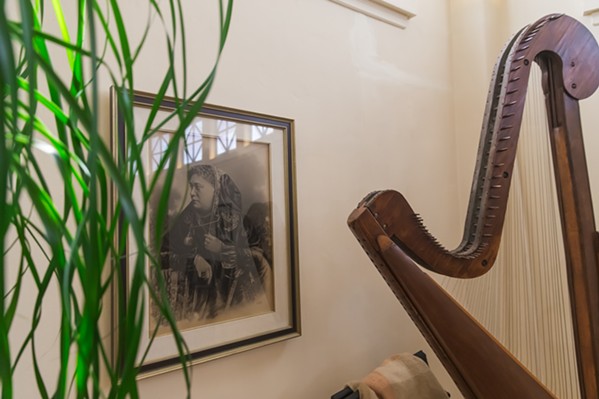
- Photo By Jayson Mellom
- PAST AND FUTURE A portrait of Helena Blavatsky, one of the founders of the Theosophical Society, rests inside the temple beside the restored harp that was hand-built by early member John Varian.
The Images of America book, penned by Shumway and Halcyon resident White, mirrors Rollison's sentiment.
"Some people have come to Halcyon expecting a utopia inhabited by saintly beings and have left deeply disappointed," the introduction reads. "They found a group of ordinary human beings with ordinary strengths and weaknesses, united by a desire to live the Golden Rule."
The temple's progressive values appealed to Rollison once he entered adulthood. Take its view on marriage, for example. The biggest distinction in how the temple conducts a wedding ceremony is the removal of the "till death do us part" phrase.
"They have a phrasing instead where the couple promises to stay together until their love shall last," he said. "That, to me, is an interesting acknowledgement that sometimes people change, and there's a provision for that."
Rollison returned to Halcyon after his last marriage ended. He lived all around the country as an adult but missed his hometown's sense of community. He had studied other religions and even analyzed atheism, but throughout those explorations, theosophy's aim of finding what unites all religions rang true for him. As did the temple's motto: "Creeds disappear, hearts remain."
Layers of faith
Temple treasurer Marti Fast's eyes widened when she first stepped foot into the Temple of the People almost 50 years ago. It was the summer of 1975, she was 23 and had made her way to Halcyon after a performance at the Great American Melodrama in Oceano. A lover of architecture, Fast was immediately enthralled.
"I remember my eyes just lifting up to the band of windows," she said on July 27. "I just thought, 'Wow!' It was such a sacred space, but it was so unusual, and it captured me."
The distinctive temple architecture still piques interest to this day. It's a site of hallowed mathematics. A wraparound porch hugs the Blue Star Temple with 36 pillars—12 on each of the three sides of the convex equilateral triangle. They represent souls who arrived at spiritual truth that lays hidden within the temple, according to a pamphlet about the temple's symbology.
The windows that caught Fast's attention each have eight panes, which represent the union of Heaven and Earth. They're placed high to symbolize the divine light that comes from above. Notably, the windows are glazed with a special opalescent glass that diffuses the sunlight into a more golden glow.
Fast, Allan Hancock College's longtime art gallery director and fine arts instructor, felt right at home. So much so that she's served as the temple treasurer for 25 years and continues to assist with the services.
Raised Episcopalian, Fast quickly found similarities between her faith and the principles of theosophy. She grew up learning about karma and reincarnation from her grandmother and mother.
"Reincarnation is hope in a way and stands for a chance to do things again. As human beings, we grow and learn from our mistakes," Fast said. "They both helped me practice the Golden Rule as a daily practice."
The first person who introduced her to the temple was Arroyo Grande High School teacher Frances Campbell. Fast had made the move from her hometown, Santa Maria, and belonged to the founding company of the Great American Melodrama of Oceano. Francie, as she called her, became the "door opener" for Fast. It helped that she was also her first landlady.
"The first time we met, we spoke for three hours about the temple and spirituality," Fast said. "She was my mentor."
Fast still considers herself to be Episcopalian as well. One faith informs and supplements the other. The link between the two is acts of service.
"I still have rootedness there [in Episcopalianism] that I don't think will ever go away," she said. "But the temple enhances every spiritual thing I have in my life. It validates that past, and no one has to give up the journey that brought them here."
Some members arrived at the temple through journeys that spanned multiple countries. Rita Moiseyeva traveled to Halcyon in 1998 from New Jersey, but she first came to the East Coast in 1994 from Ukraine because of a Russian book that spoke about a theosophical community in the U.S.
"Probably 99 percent of Russian speaking members [of the temple] learned about this community through that book," Moiseyeva said. "It's an esoteric novel that in its epilogue mentions that this community was founded in Syracuse, New York, and then they moved to California."
That book—Two Lives by Russian singer and theosophist writer Concordia Antarova—compelled Moiseyeva and her husband, Sergey Moiseyav, to seek out the Temple of the People as soon as they got to the East Coast. A visit to the Nicholas Roerich Museum in New York brought them face to face with its director, and soon the conversation turned to the Temple of the People.
"He just pulled out of his pocket the phone number of the office in Halcyon! It was a miracle, and we had lost hope by then," Moiseyeva said.
Moiseyav, her husband, called and spoke with then Guardian-in-Chief Shumway who encouraged them to visit in 1998. The family eventually became permanent Halcyon residents in 2000.
"You know, if you put your idea out there, the universe starts working with you," Moiseyeva said with a laugh.
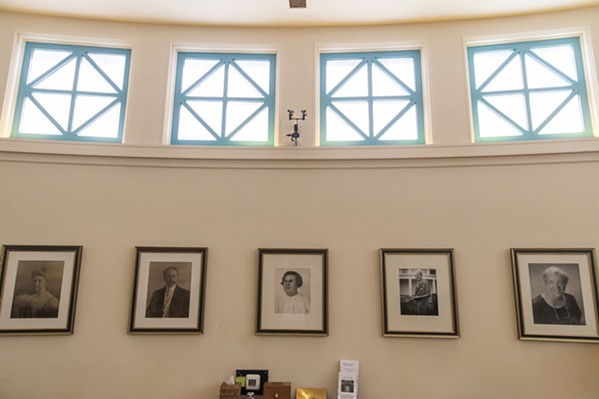
- Photo By Jayson Mellom
- PROGRESSIVE ORDER From left to right and in chronological order, portraits of former Guardians-in-Chief Francia LaDue, William Dower, Pearl Dower, Harold Forgostein, and Eleanor Shumway are honored inside the Temple.
The biggest gift the temple's given to her is unity. She felt it most deeply after her husband passed away a few years ago in an accident, and the Halcyon community banded together to uplift her. Just before he passed, her husband was in the middle of a construction project in the family yard. Moiseyeva was at a loss for what to do.
"I was a wreck; I asked Eleanor, 'What do I do with this now?'" she recalled. "It happened on a Wednesday. That Saturday ... all the neighbors came and put everything to order and fixed and cleaned everything."
Moiseyeva told New Times that she never felt alone thanks to the Halcyon residents. She's now the inner guard of the temple and helps London manage the services. Her daughter is also a member.
"I don't know in what other geographical location would I have made it through," she said. "It's absolutely amazing that we are still here because those who came before us made it happen. They preserved it, kept it alive, and it still exists with the same intention."
Beyond Halcyon
The Halcyon community may be quiet, but it's not underground.
At the local level, residents advocate for resources from the Oceano Community Services District (OCSD). Temple Guardian-in-Chief London serves as Halcyon's de facto mayor of sorts through interactions with the OCSD and other governing bodies like the Central Coast Regional Water Quality Control Board
"When Eleanor let me know I'd be following her, I had been mostly connected with the spiritual side of the temple, not the residential side of the temple," London said. "I ended up going up and representing her at the local regional water board meetings."
London started attending these meetings a year before he became guardian-in-chief. The prime reason is to find an alternate source of potable water for residents. The original source—the Halcyon well operating since 1903—has been increasingly contaminated over the years by rising manganese levels.
"Then other chemicals started appearing, mostly from the area becoming more and more populated," London said. "The Temple of the People owned the Halcyon well, and we were distributing the well water to about 67 homes."
The temple needed a permit to do that, and keeping that permit active required periodic water testing by the county.
"In the last year or two, we were having to do more and more to filter the water to be compliant," London said. "It got to the point where we needed to figure out a way to be more proficient in keeping the water potable, and that's when the water board got very involved."
A state-funded feasibility study found alternate solutions, but most of them were too costly for Halcyon. An affordable solution was to get water from the OCSD and retain the well water for irrigation. Currently, Halcyon residents fill up water from a reverse osmosis system that's under lock and key. They pay a small monthly fee for that water connection.
"I've filled many a jug there," London said with a laugh. "I expect us to be receiving [OCSD] water by probably 2025 as a way to bring potable water directly to households."
The temple also made itself known at the state and federal levels. Thanks to Shumway's and White's petitioning efforts, it became a historic district in 2017 after being nominated for inclusion in the National Register of Historic Places by the California State Office of Historic Preservation.
In mid-August, a week after London attended the Temple Convention, the current guardian-in-chief expressed satisfaction as he looked forward to the temple's 100th anniversary.
"People had shared their thoughts on the convention theme: There is no going back," he told New Times. "You can't go back to the way things were. But you can always return to the principles, the higher aspects of how we relate to one another." Δ
Reach Staff Writer Bulbul Rajagopal at [email protected].
Clarification: This story was updated to reflect when the Feast of Fulfillment was opened to the public.


Comments